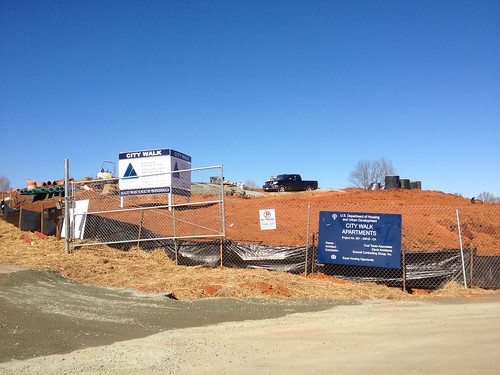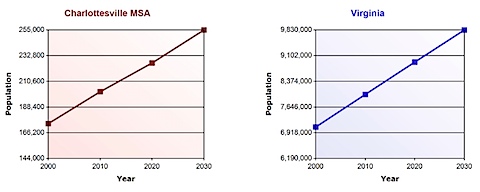Goodbye, Charlottesville Bubble Bloggers. Today marks their final post . Thanks for the insight, the forced introspection and for bringing some life to the Charlottesville real estate conversation. Please don’t let your blog become yet another abandoned internet place feeding dead links.*
Mid-2008 brought the advent of the Charlottesville Bubble Bloggers. Much consternation followed in the Charlottesville real estate agent community. They brought candor, some snark, brutal analysis and anonymity to the Charlottesville real estate conversation.
I, for one, welcomed them – engaged them thoughtfully and I’d like to think earned their respect (and they mine).
Late 2008 I interviewed them – all three of them – Jane, John and Snarky Doe – in a two-part email interview. Part One. Part Two.
Late 2009 they reviewed a bunch of houses (something I think a whole bunch of buyers would like to see more of).
And then in 2011 they interviewed some of the Charlottesville real estate agents who had engaged them** on their blog (as an aside, that image remains one of my all-time favorites).
Late 2012 they put together their thoughts on the Charlottesville market.
And so now, they are moving on … and have been so kind as to answer a few of my questions.
1 – Who are you? (don’t worry, we won’t tell anyone)
In the beginning “we” were several people who were interested in/shocked by prices/obsessed with real estate in Charlottesville and Albemarle. Though in ’08 and ’09 there was lot of blog snark (which was true across the Internets), we actually did and *do* love Charlottesville. It’s a fantastic place to live, and it’s too bad the secret is out. This makes the traffic truly awful; sometimes it seems very crowded; and RE prices are up, for good. (More on how that is true, and not true, in the final post on the C’ville Bubble Blog).
2009 and 2010 were awful years for the American Economy, home owners, savers, and millions of workers. Our belief system turned to Econogeddon and Prepper, and we became hand-wringers over the control Too Big to Jail Banks had and have over the US Government and political parties, property-owners, and potential buyers. We chronicled this in terms of the local and national.
It remains a fact that many people will never recover their standard of living and neither would have the rest of us w/out the kick-the-can-down-the-road heroics of money-printing Fed Chair Ben Bernanke and Treasury Sec Tim Geithner.
Along the way, through life-changes and the improving economy, “we” morphed into “I”…around the time the blog took to Twitter. Tweeting is a lot more efficient than blogging, though certainly not less time-consuming. 2011 was a busy year of blogging–but mostly because there was a lot going on.
There were signs that housing was entering a new phase by early 2012, with the National Fraudclosure Settlement, though it ultimately was to provide not much relief for home owners. There was a New Year’s resolution to wrap up the blog…which got derailed. But the last blogger standing did manage to generate 80% less content than previous years :0).
2a. Okayfine. Could you have written as you have had you not been anonymous?
Now that it’s 2013, an anonymous blogger or internet entity might need to be explained. The Internet now is Nice. But back when the blog started, mid-2008, ‘anonymity’ on the web was still a viable, if not preferable, option. Many people still had funny little names as email addresses, and blogged, or commented on blogs, with wacky monikers.
Locally, there was an extremely popular website / gossip extravaganza called The Cvillain, which was up-to-the second, in-the-know, controversial, snarky, anonymous. Nationally, there were a number of housing and econ blogs that were widely read and anonymous: Zero Hedge with lead blogger Tyler Durden; Dr. Housing Bubble; Calculated Risk, who was known as CR (but is now known as Bill McBride), who co-blogged with one of the best writers about mortgages and the bubble, called Tanta, whose identity was only revealed after she died in 2009. There was precedence.
Could we have written the same if we had not been anonymous? Probably not. People would have looked at our current or previous jobs or pursuits or financial status or owner status, rather than the data on the blog.
What’s equally interesting as our own (and my own) anonymity is the kind of people who rejected it or accepted it. There’s one particular TV station in town that wouldn’t have anything to do with the blog, at least publicly. But NBC29 and Daily Progress, The Hook, and C-VILLE reporters were savvy enough to use it as a resource and interact via Twitter.
Too, the blog had long-term private email and Twitter correspondence with a number of area RE agents, home buyers and sellers, finance guys, UVA profs. None of the correspondents spent too much time pondering the anonymous question.
2 – Do you think the bottom is here? The end of 2011, and the Q1 of 2012 was, anecdotally, the bottom of the bust. I believe the City of Charlottesville and Albemarle County have seen their price bottoms, especially in the “First Time Homebuyer” category of under $300k. It’s a question of very low inventory. Here’s a national chart on pricing which confirms pricing ideas.
But the most convincing bit of data for Q4 2011/ Q1 2012 being the bottom is that several of the blog’s long-term commenters / correspondents bought houses: “Serious Buyer,” “Craigger,” “Anonymous,” among them.
These folks tracked the local and nat’l markets closely for years and independently decided to finally buy, deciding if it wasn’t “the” bottom, it was close enough. And with mortgage interest rates solidly under 4%, they were all happy.
Read More




